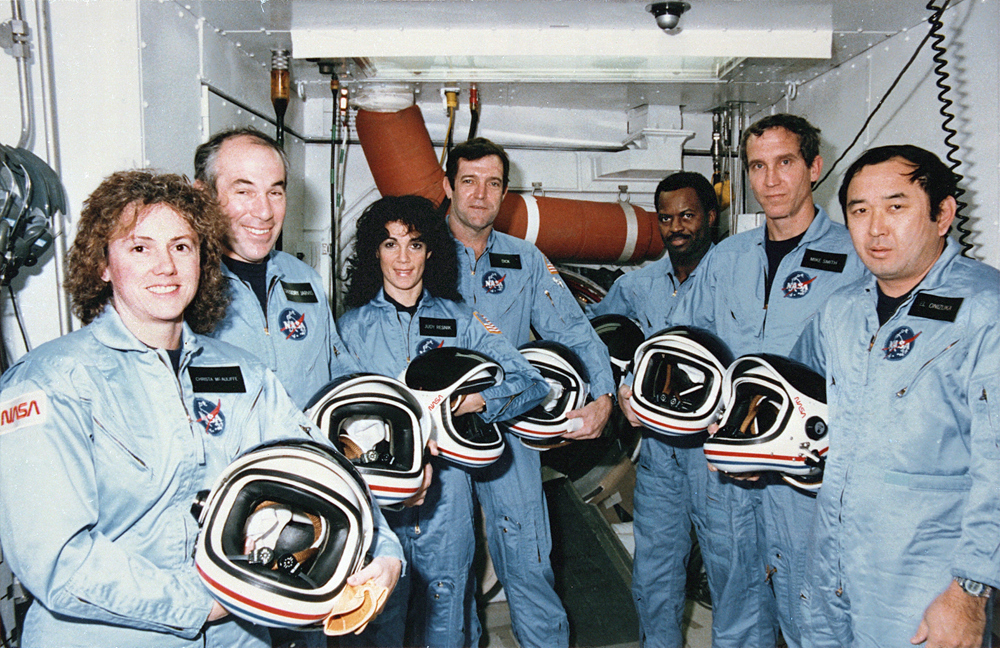Tense Debates Before Challenger Shuttle Disaster Revealed in PBS 'Retro Report' (Exclusive Video)
An exclusive clip from PBS shows the difficult conversations that took place before the fatal Challenger space shuttle explosion in 1986, which killed seven astronauts during launch.
The segment appears in an upcoming episode of "Retro Report," a 1-hour magazine-format series that premiered Oct. 7. The series aims to give viewers a different perspective on current headlines by providing information about related, past events. This episode will air today (Oct. 28) at 9 p.m. EDT; check local listings for other time zones.
The causes of the Challenger accident were manifold, but some of the chief factors — as identified by the investigation board — pointed to a failed O-ring seal on one of the shuttle's solid rocket boosters, as well as schedule pressure by NASA to launch as many shuttles as possible each year.
Video: Challenger Explosion Investigation Recalled in PBS 'Retro Report'
Related: Remembering Challenger: NASA's 1st Shuttle Tragedy in Photos

The primary O-ring seal cracked due to cold temperatures on the launchpad, allowing burning propellant to escape and eventually cause an explosion. As the PBS segment reminds viewers, this wasn't the first time the primary seal failed during a launch, although, each time, a secondary seal stopped the propellant from going any farther.
"NASA kept very good records of anomalies. The problem is, they ran into a lot of these," said Allan McDonald in the PBS clip. He was an executive from booster manufacturer Morton Thiokol who, along with many engineers on his team, warned NASA that the temperatures on launch morning were dangerous.
Diane Vaughan, a Columbia University sociologist and author of "The Challenger Launch Decision" (University of Chicago Press, 1996), pointed out that NASA had run many O-ring tests before Challenger's fatal launch.
Get the Space.com Newsletter
Breaking space news, the latest updates on rocket launches, skywatching events and more!
"The first time it happened, they accepted it, they tested it, they thought they knew what had happened. And the next launch, everything worked. And then a few more launches, it happened again," she said in the same clip.
NASA's conclusion at the time was that a secondary O-ring would prevent the gases from escaping, even if the primary O-ring failed. "Even with the worst O-ring erosion they ever had, it hadn't failed," Vaughan added. "It didn't seem so terrible. They continually expanded the balance of acceptable risk."
The last Challenger launch was the 25th mission of the space shuttle program, which had been running for almost five years by the time the shuttle lifted off for the last time, on Jan. 28, 1986. This particular launch received more attention than usual, even before the explosion, because of the presence of Christa McAuliffe, who won a nationwide competition to be the first teacher in space.
McDonald recalled getting a phone call from Morton Thiokol engineers in Utah the night before the launch, saying that temperatures could get as low as 18 degrees Fahrenheit (minus 8 degrees Celsius) the morning of the launch. "'Good grief,' I said. 'I'm really worried about those O-ring seals being able to operate properly in those kinds of temperatures,'" McDonald said.
NASA and Morton Thiokol held an emergency teleconference the night before the launch. Morton Thiokol recommended that managers wait until the temperature was at least 54 F (12 C) before launching, but NASA managers said they recommended going ahead.
NASA executive Larry Mulloy, manager of the space shuttle's solid rocket booster program, said he remembers a visibly upset McDonald telling him that McDonald didn't want to be the person who had to appear at a board of inquiry "if this thing blows."
Mulloy added, "I said, 'I understand that, Allan. You won't have to. That will be me.'"
- Michelle Williams to Portray Christa McAuliffe in 'The Challenger'
- The Space Shuttle Challenger Disaster: What Happened? (Infographic)
- PBS Series 'Chasing the Moon' Takes a New Look at the Apollo-Era Space Race
Follow Elizabeth Howell on Twitter @howellspace. Follow us on Twitter @Spacedotcom and on Facebook.
Join our Space Forums to keep talking space on the latest missions, night sky and more! And if you have a news tip, correction or comment, let us know at: community@space.com.

Elizabeth Howell (she/her), Ph.D., was a staff writer in the spaceflight channel between 2022 and 2024 specializing in Canadian space news. She was contributing writer for Space.com for 10 years from 2012 to 2024. Elizabeth's reporting includes multiple exclusives with the White House, leading world coverage about a lost-and-found space tomato on the International Space Station, witnessing five human spaceflight launches on two continents, flying parabolic, working inside a spacesuit, and participating in a simulated Mars mission. Her latest book, "Why Am I Taller?" (ECW Press, 2022) is co-written with astronaut Dave Williams.









